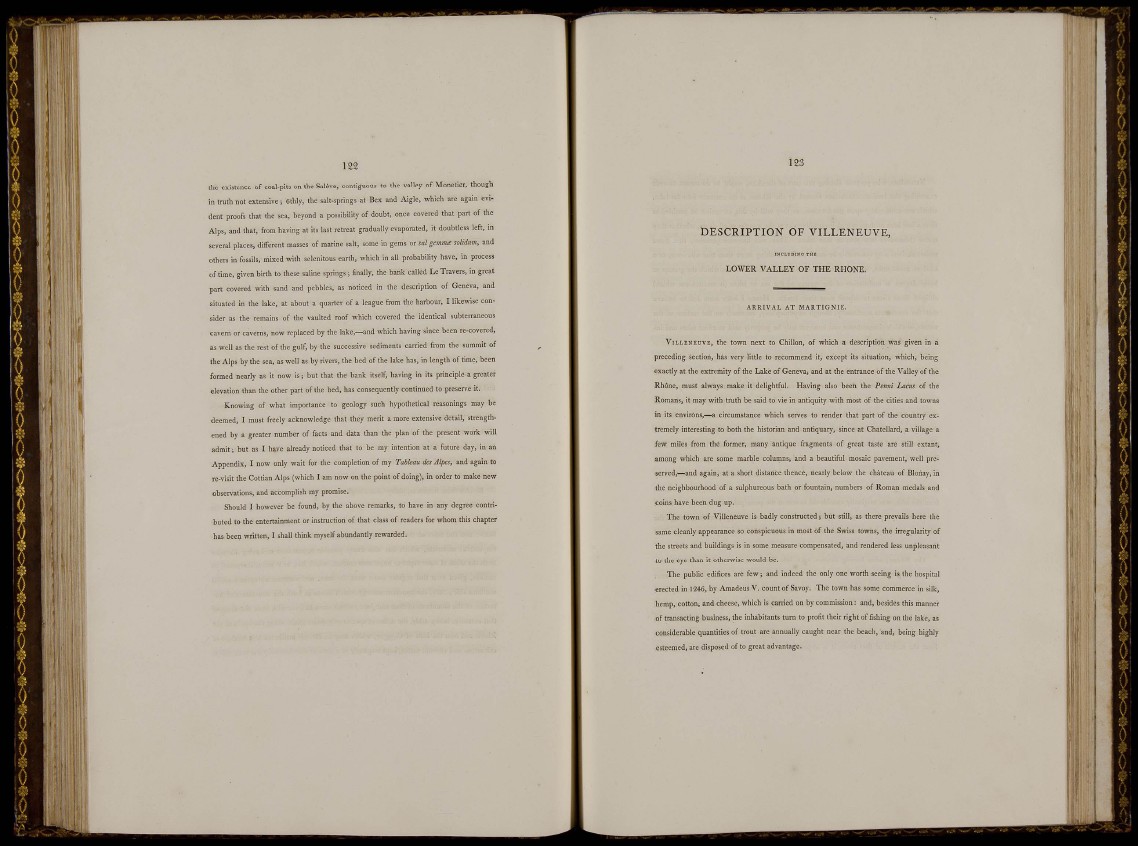
ill
1 2 2
the existence of coal-pits on the Saleve, conti j u o u s to the valley of Monetier, though
in truth not extensive, Othly, the salt-springs at Bex and Aigle, which are again evident
proofs that the sea, beyond a possibility of doubt, once covered that part of the
Alps, and that, from having at its last retreat gradually evaporated, it doubtless left, in
several places, different masses of marine salt, some in gems or ml gmma: soUdum, and
others in fossils, mixed with selenitous earth, which in all probability have, in process
of time, given birth to these saline springs; finally, the bank called Le Travers, in great
part covered with sand and pebbles, as noticed in the description of Geneva, and
situated in the lake, at about a quarter of a league from the harbour, I likewise consider
as the remains of the vaulted roof which covered the identical subterraneous
cavern or caverns, now replaced by the lake,—and which having since been re-covered,
as well as the rest of the gulf, by the successive sediments carried from the summit of
the Alps by the sea, as well as by rivers, the bed of the lake has, in length of time, been
formed nearly as it now is; but that the bank itself, having in its principle a greater
elevation than the other part of the bed, has consequently continued to preserve it.
Knowing of what importance to geology such hypothetical reasonings may be
deemed, I must freely acknowledge that they merit a more extensive detail, strengthened
by a greater number of facts and data than the plan of the present work will
admit I but as I have already noticed that to be my intention at a future day, in an
Appendix, I now only wait for the completion of my Tableau des Alpes, and again to
re-visit the Cottian Alps (which I am now on the point of doing), in order to make new
observations, and accomplish my promise.
Should I however be found, by the above remarks, to have in any degree contributed
to the entertainment or instruction of that class of readers for whom this chapter
has been written, I shall think myself abundantly rewarded.
1 2 3
DESCRIPTION OF VILLENEUVE,
LOWER VALLEY OF THE RHONE.
ARRIVAL AT MARTIGNIE.
VILLENEUVE, the town next to Chillón, of which a description was given in a
preceding section, hás very little to recommend it, except its situation, which, being
exactly at the extremity of the Lake of Geneva, and at the entrance of the Valley of the
Rhône, must always make it delightful. Having also been the Penni Lactis of the
Romans, it may with truth be said to vie in antiquity with most of the cities and towns
in its environs,—a circumstance which serves to render that part of the country extremely
interesting to both the historian and antiquary, since at Chatellard, a village a
f ew miles from the former, many antique fragments of great taste are still extant,
among which are some marble columns, and a beautiful mosaic pavement, well pre-*
served,—and again, at a short distance thence, nearly below the château of Bloiiay, in
the neighbourhood of a sulphureous bath or fountain, numbers of Roman medals and
coins have been dug up.
The town of Villeneuve is badly constructed ; but still, as there prevails here the
same cleanly appearance so conspicuous in most of the Swiss towns, the irregularity of
the streets and buildings is in some measure compensated, and rendered less unpleasant
to the eye than it otherwise would be.
The public edifices are few j and indeed the only one worth seeing is the hospital
erected in 1246, by Amadeus V. count of Savoy. The town has some commerce in silk,
hemp, cotton, and cheese, which is carried on by commission : and, besides this manner
of transacting business, the inhabitants turn to profit their right of fishing on the lake, as
considerable quantities of trout are annually caught near the beach, and, being highly
esteemed, are disposed of to great advantage,